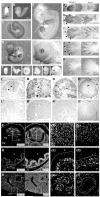Visualization of the expression of HMGN nucleosomal binding proteins in the developing mouse embryo and in adult mouse tissues
- PMID: 19381921
- PMCID: PMC3402339
- DOI: 10.1007/978-1-59745-190-1_5
Visualization of the expression of HMGN nucleosomal binding proteins in the developing mouse embryo and in adult mouse tissues
Abstract
Visualization of the expression pattern of specific proteins during development and in adult tissues provides important clues as to their possible role in various cellular processes. Mouse is the organism of choice for obtaining information on gene expression patterns in higher eukaryotes. This chapter describes the protocols we utilized to visualize Hmgn transcripts and HMGN proteins in mouse tissues. HMGN are chromatin-binding proteins that affect chromatin structure and function and play a role in cellular differentiation.
Figures


Similar articles
-
Developmental function of HMGN proteins.Biochim Biophys Acta. 2010 Jan-Feb;1799(1-2):69-73. doi: 10.1016/j.bbagrm.2009.11.011. Biochim Biophys Acta. 2010. PMID: 20123069 Free PMC article. Review.
-
HMGN5/NSBP1: a new member of the HMGN protein family that affects chromatin structure and function.Biochim Biophys Acta. 2010 Jan-Feb;1799(1-2):86-92. doi: 10.1016/j.bbagrm.2009.09.012. Biochim Biophys Acta. 2010. PMID: 20123071 Free PMC article. Review.
-
Developmental role of HMGN proteins in Xenopus laevis.Mech Dev. 2003 Oct;120(10):1177-92. doi: 10.1016/j.mod.2003.07.001. Mech Dev. 2003. PMID: 14568106
-
High mobility group N proteins modulate the fidelity of the cellular transcriptional profile in a tissue- and variant-specific manner.J Biol Chem. 2013 Jun 7;288(23):16690-16703. doi: 10.1074/jbc.M113.463315. Epub 2013 Apr 24. J Biol Chem. 2013. PMID: 23620591 Free PMC article.
-
Epigenetic Regulation of Ameloblast Differentiation by HMGN Proteins.J Dent Res. 2024 Jan;103(1):51-61. doi: 10.1177/00220345231202468. Epub 2023 Nov 10. J Dent Res. 2024. PMID: 37950483 Free PMC article.
References
-
- Bustin M. Chromatin unfolding and activation by HMGN(*) chromosomal proteins. Trends Biochem Sci. 2001;26:431–7. - PubMed
Publication types
MeSH terms
Substances
Grants and funding
LinkOut - more resources
Full Text Sources

